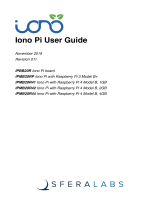Page is loading ...

1
AWZ518
v1.1
PC2
Timing relay module
Edition: 4 from 01.03.2018
Supersedes: 3 from 11.02.2014
1. Description.
The PC2 timing relay module is intended for AC power status control in object alarm systems (monitoring
transmitters, alarm control panels, DC power supply units, etc.). The module informs about AC power loss with a preset
delay time T and its return. Momentary return of the AC power during the T delay countdown will reset the countdown
(stop and return to normal state). The module is equipped with an AC1 input which shall be connected to one of the
secondary winding of the transformer that supplies the device (the module must be powered with 12V/DC of the device to
which the controlled terminal of the transformer is connected). PC2 has two OC outputs (OC1, OC2) and an LED (L1)
indicating the device’s status. Delay time indicating AC power loss is adjustable via two jumpers – Z1, Z2.
Fig.1. A diagram of the PC2 connection (example).
2. Description of components and connectors of the module.
Nr
[rys.2]
Description
[1]
L1 green LED - module’s status indication
permanently illuminated: presence of AC power at AC1 terminal,
presence of VDC power of the module
twinkles 1x/1s: no AC power at AC1 terminal, delay time countdown
off: the module has finished the countdown and changed the status of OC outputs
(alternatively - no 12V DC power)
[2]
Z1, Z2 jumpers - adjustable time delay of AC power failure indication
Z1= , Z2= time delay T= 4s
Z1= , Z2= time delay T= 1 min
Z1= , Z2= time delay T= 16 min
Z1= , Z2= time delay T= 4h 15 min
jumper on
jumper off
[3]
Connectors
AC1 – input of controlled AC voltage (one of terminals of the transformer’s secondary winding)
+VDC- DC power input
OC1 - OC output (open collector) indicating AC power status:
normal state: L (0V, GND),
active state: hi-Z (high impedance)
OC2 - OC output (open collector) indicating AC power status:
normal state: hi-Z (high impedance)
active state: L (0V, GND) OC type
Normal state: AC voltage presents at the AC1 terminal or after AC power loss
Active state: no AC voltage at the AC1 terminal, delay time countdown is finished
EN*

2
3. Specifications.
Supply voltage
10V ÷ 15V DC
Current consumption
5 mA
T delay adjustment range
4s/1min/16min/4h 15min (+/-10%)
AC1 input
0V ÷30V AC
Inactive input: 0V ÷1V AC
Active input: 5V ÷30V AC
GND= ‘VDC-‘ power terminal
Technical outputs:
- OC1 output
- OC2 output
OC type 50mA max.
normal state: L (0V, GND),
active state: hi-Z (high impedance)
normal state: hi-Z (high impedance)
active state: L (0V, GND)
LED indication
L1 green LED
Operating conditions
II environmental class, -10°C ÷ 50°C
Dimensions
L=60, W=43, H=23 [mm, +/-2]
Installation
A mounting panel with an adhesive
tape,mounting screws x2 (holes 3mm)
Connectors
Ф0,41÷1,63 (AWG 26-14)
Net/gross weight
0,03kg /0,05 kg
Declarations, warranty
CE, RoHS, 2 year from the production date
Fig.2. The view of the PC2 module.
4. Installation.
The module is to be mounted by a qualified installer, holding relevant permits and licenses (applicable and
required for a given country) for 230V/AC and low-voltage installations. The unit should be mounted in confined spaces,
in accordance with the II environmental class, with normal relative humidity (RH=90% maximum, without condensation)
and temperature from -10°C to + 50°C.
The device shall be mounted in a metallic enclosure (a cabinet, a final case). In order to fulfil LVD and EMC requirements,
the rules for: power-supply, encasing and screening shall be followed, according to application.
1. Mount the enclosure (cabinet etc.) and lead the cables through the cable ducts.
2. Install the PC2 time module on the installation terminal.
3. Lead the DC supply power to the +VDC, -VDC terminals, keep polarisation.
4. Lead the AC controlled power to the AC1 terminal.
5. Connect the AC power loss signal: OC1 or OC2 (depending on application requirements) to the indicating device
(LED, transmitter’s input, control panel’s input, indicator, etc.)
6. With Z1, Z2 jumpers, choose the indication delay time of the OC1 and OC2 outputs.
7. Once the tests and operation control have been completed, the enclosure / cabinet can be locked.
Pulsar
Siedlec 150, 32-744 Łapczyca, Poland
Tel. (+48) 14-610-19-40, Fax. (+48) 14-610-19-50
http:// www.pulsar.pl, www.zasilacze.pl
WEEE PARKING
According to the EU WEE Directive – It is required not to dispose of electric or electronic waste as unsorted municipal waste
and to collect such WEEE separately.
Zużytego sprzętu elektrycznego i elektronicznego nie wolno wyrzucać razem ze zwykłymi domowymi odpadami. Według dyrektywy WEEE
obowiązującej w UE dla zużytego sprzętu elektrycznego i elektronicznego należy stosować oddzielne sposoby utylizacji.
/



